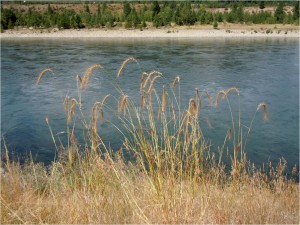Native Plant Propagation Basics
Successfully grow your own native plants by mimicking nature throughout the year.

Seed collection
While it is possible to grow native plants from cuttings, growing from seed has many benefits. Collecting seed has a smaller impact on a site than taking cuttings; seeds are easier to store than cuttings and also help ensure genetic diversity.

Canada wildrye with ripe seeds.
I suggest identifying the plants you would like to collect seeds from early in the year, when they are blooming, as this is often the easiest time to identify the plants and to spot them. The time from flowering to ripe seed varies from species to species, annually and from one site to the next. Visit the plant regularly and take notes on seed ripening.
You can tell that seeds are ripe when they change from white or yellow to tan or brown. Unripe seeds are soft and often milky when squeezed. Ripe seeds are found in ripe fruits or berries, or in opening seedpods. It can be tricky to harvest ripe seed at the correct time. Harvest too early and germination rates will be low, wait too long and the birds or bears may have gotten to the nutritious seeds before you.
Now that you have ripe berries or fruits in hand it’s time to extract and clean the seed. This is not as difficult as it sounds. What you want to do is remove the pulp since it often has germination inhibitors and also will lead to mould and rot in storage. Use screens or a kitchen mixer to remove most of the pulp. Rinse the seed several times to remove the rest. Spread the cleaned seed on paper towels or tea towels. In a few days the seed will be dry enough to store. Store your seed in plastic bags or containers in the freezer. Make sure to add a label with species and collection information to each bag. Storing seed in the freezer helps kill pests and preserve seed.
In the late fall, before the first snow, get the seed out of the freezer. Fill flats or pots with potting soil and sprinkle seed on the surface. Cover lightly and label each container. Write date sown and species on each label. Set the pots out where it will rain and snow on them all winter. By leaving the seeds out through the winter they are subject to cool, moist conditions (stratification) just as they would be in the wild. Make sure that birds and rodents can’t get to the seeds in pots – cover with window screen or hardware cloth. See that there are no gaps around the edges.
From seed to seedlings
In early spring you can bring the pots into your greenhouse. If you don’t have a greenhouse, just set them aside in your garden. During spring seedlings will emerge and you can transplant them once they have a set of true leaves. Some species will grow quickly during the first summer, others more slowly. Make sure you water your new seedlings regularly. Transplant if they seem root bound. Check to make sure that the roots of plants with long taproots aren’t growing out of the container.
You can plant the seedlings in the fall or spring. Spring is good if they seem to be filling the container. Fall is fine if you can keep them well watered and out of the hot sun all summer. Help them along the first while after planting – water and weed for a few years to ensure good growth.
Congratulations – you are now a native plant propagator!

Guidelines for Collecting Native Plant Seeds
Collecting your own seed from healthy plant populations can be a good way to grow wild.
Gardeners must think about the impacts their collecting has on the wild. There are a number of excellent guidelines, listed below, of how to collect seeds without damaging native plant communities.

Plant Collection Guidelines for Horticultural Use of Native Plants
Alberta Native Plant Council
Gardeners should be aware that indiscriminate collecting of wild plants can threaten native plant populations and their habitats. The Alberta Native Plant Council encourages gardeners and nursery operators to be aware of acceptable ways to acquire native plants and to choose their species wisely.
Many plant societies across North America and in Europe have developed guidelines for the horticultural use of native plants. The guidelines that follow are based on those developed by the Maryland Native Plant Society using information from the North American Native Plant Society.
http://www.anpc.ab.ca/assets/gardener_guidelines.pdf
Guidelines for Collecting Native Plants
Montana Native Plant Society
These guidelines were developed to help those wishing to collect native plant material to do so without damaging our native plant populations and communities.
http://www.mtnativeplants.org/filelib/58.pdf
Native Plant Propagation Guidelines
Garry Oak Ecosystems Recovery Team
A compendium of propagation information for plant species characteristic of Garry oak and associated ecosystems in British Columbia. Includes seed collection guidelines.
